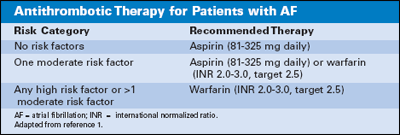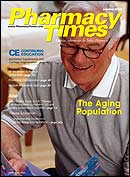Aggressive AFTreatment Reduces Stroke Incidence
New guidelines for managing patients with atrial fibrillation emphasize stroke prevention.
Ms. Terrie is a clinical pharmacy writerbased in Haymarket, Virginia.
Atrial fibrillation (AF) is the mostprevalent type of arrhythmia inclinical practice and can presentwithout symptoms. AF accountsfor an estimated 33% of hospitalizationsdue to cardiac rhythm disturbances.1The rate of AF occurrence has increasedsignificantly over the past 20 years.1Two and a half million individuals in theUnited States are affected by the condition.1,2 The incidence of AF increaseswith age; recent statistics indicate thatAF affects an estimated 5% of patientsolder than 69 years and 8% to 10% ofthose older than 80 years.2-4 In addition,AF appears to occur more frequently inmen than women.2-4
Types of AF are defined in Table 1.According to the American HeartAssociation (AHA), approximately 15%to 25% of strokes occur in patientswith AF, and approximately half of theelderly with AF have hypertension.1,2,4,5A 20% to 40% risk of postoperativeincidence of AF is associated withpatients who have undergone cardiac,pulmonary, or esophageal surgery.1 AFalso can cause 5% to 10% of acutemyocardial infarctions.2
Risk factors of AF include advancedage, male gender, uncontrolled hypertension,valvular heart disease, coronaryartery disease, ventricular hypertrophy,pericarditis, diabetes, hyperthyroidism,certain pulmonary disorders, and a historyof smoking.2,3,6 The 2 major complicationslinked with AF are AF-associatedstroke and heart failure.6 Other complicationsinclude arterial embolization,severe bradycardia, and rate-relatedmyocardial ischemia.3 Although AF canbe asymptomatic, patients may experiencevarious symptoms including dizziness,palpitations, dyspnea, fatigue,syncope, weakness, and angina.2,3,8
Table 1

Treatment
In August 2006, revisions to the 2001AF guidelines were published by theAmerican College of Cardiology, theAHA, and the European Society ofCardiology in a report entitled Guidelinesfor the Management of Patients withAtrial Fibrillation. These guidelines reflectresults from recently published clinicaltrials. They state that the use ofpharmacologic agents and ablation areeffective for both rate and rhythm control.1 In addition, surgery may be thefavored choice under certain circumstances.1 Regardless of the treatmentapproach, the need for anticoagulationtherapy is based on stroke risk, not onwhether sinus rhythm is maintained.1The new guidelines place strong emphasison stroke prevention and alsostate that controlling cardiac rate isequally effective to controlling cardiacrhythm.1,4 Also, results from several studiessupport the conclusion that heart-ratecontrol is better tolerated and mayhave better results in certain patients.4
The therapy goals in treating AFinclude maintaining sinus rhythm, preventingthromboembolism, and correctingthe rhythm disturbance.1,2According to the guidelines, severalfactors should be considered whenestablishing a plan to manage AF1:
- Type and duration of AF
- Severity and type of symptoms
- Other possible cardiovascular diseases
- The patient?s age
- Other preexisting medical conditions
- Short- and long-term treatment goals
- Pharmacologic and nonpharmacologic therapeutic options
Heart-rate Control
According to the new guidelines,rate control may be considered as aninitial therapy for older patients withpersistent AF who have hypertensionor cardiovascular disease, based onthe degree of patient symptoms.1The pharmacologic agents used fortreating AF can be classified into 2general classes: rate controlling andrhythm restoring.2 Beta-blockers andcalcium channel blockers are thedrugs of choice for rate control.2
The use of pharmacologic agentssuch as beta-blockers and nondihydropyridinecalcium channel blockersare recommended in most cases forpatients with persistent or permanentAF, according to the new guidelines.1 In patients without ventricularpre-excitation, the use of intravenousbeta-blockers (eg, esmolol, metoprolol,propranolol) or nondihydropyridinecalcium channel antagonists(eg, verapamil, diltiazem) is recommendedto slow the ventricularresponse to AF in the acute setting;caution should be used in patients withhypotension or heart failure.1,3,8 Beta-blockersinitially should be used withcaution in patients with AF and heartfailure who have reduced ejection fraction.1 The major adverse effects associatedwith the use of esmolol and otherbeta-blockers include hypotension andbronchospasm.1 Caution should beused in individuals with heart failurebecause of the negative inotropiceffects associated with the nondihydropinecalcium channel blockers,which may cause hypotension.1 Thelong-term use of calcium channelblockers may be a more favorable drugof choice over beta-blockers in patientswith bronchospasm or chronicobstructive pulmonary disease.1-3 Insome cases, the administration ofdigoxin or amiodarone intravenouslyalso is recommended to control theheart rate in patients with AF and heartfailure who do not have an accessorypathway.1
Digoxin is no longer considered afirst-line therapy for rapid managementof AF, except in patients with heart failureor left ventricle dysfunction, becauseof the various other effectivepharmacologic agents available.1 Resultsfrom the Atrial Fibrillation FollowupInvestigation of Rhythm Managementstudy showed that with or withoutdigoxin, the use of beta-blockerswere the most effective drug class forrate control, achieving the specifiedheart rate end points in 70% of patients,compared with 54% with theuse of calcium channel blockers.1
In some cases of AF, the use of acombination of pharmacologic agentsmay be necessary to achieve adequaterate control, but clinicians should usecaution to avoid incidences of bradycardia.1 Catheter ablation should beconsidered in some cases to sustainsinus rhythm in patients who did notrespond to antiarrhythmic agents.1
Table 2

Rhythm Control
In general, the use of pharmacologicagents for rhythm control is the firstchoice for therapy. Left atrial ablation isa second-line choice, particularly inpatients with symptomatic lone AF.1The administration of flecainide,dofetilide, propafenone, or ibutilide isrecommended for pharmacologic cardioversionof AF, and a reasonableoption is the use of amiodarone.1 Theadministration of quinidine or procainamidemay be considered for pharmacologiccardioversion of AF, but theeffectiveness of these agents is notconfirmed.1 The guidelines also statethat digoxin and sotalol may be consideredharmful when used for pharmacologiccardioversion of AF and are notrecommended.1 In addition, the use ofquinidine, procainamide, disopyramide,and dofetilide should not be initiatedout of a hospital setting for the conversionof AF to sinus rhythm.1
Stroke Prevention
The AHA recommends aggressivetreatment of AF because effectivetreatment is beneficial in reducing theincidence of stroke.6 The long-term useof warfarin in patients with AF andother risk factors associated withstroke may reduce the risk of a strokeby as much as 68%.6 With regard toantithrombotic therapy for individualswith AF, the new guidelines outline recommendationsin 3 categories (Table 2).
In addition to pharmacologic therapy,a variety of nonpharmacologic therapiesmay be appropriate for somepatients and considered to maintainsinus rhythm in selected patients whofailed to respond to or are unable totolerate antiarrhythmic drug therapy.Examples include left atrial ablation,the maze operation, atrioventricularnodal ablation, and pacing.1
Additional Preventive Care
Although not extensively studied,the use of statins has been suggestedto protect against AF, and dietary lipidcomponents may be beneficial tothose with a predisposition to AF.1Results from a study published in theAugust 2007 issue of the AmericanJournal of Cardiology report that individualstaking statins were significantlyless likely to have new-onset AF.9
For more in-depth information onthe 2006 ACC/AHA/ESC Guidelinesfor the Management of Patients withAtrial Fibrillation, please visit circ.ahajournals.org.
Results from experimental and clinicalstudies also have shown that theuse of angiotensin-converting enzyme(ACE) inhibitors and angiotensin receptorantagonists may decrease the incidenceof AF.1 These studies havedemonstrated that in patients with AF,the use of agents such as ACEinhibitors may decrease atrial pressure,decrease the frequency of atrialpremature beats, reduce fibrosis, anddecrease the relapse rate after cardioversion.1
References
- ACC/AHA/ESC 2006 Guidelines for the Management of Patients with Atrial Fibrillation. American Heart Association. Circulation. 2006;114:e257-e354. circ.ahajournals.org/cgi/content/full/114/7/e257. Accessed December 12, 2007.
- Rosenthal L. Atrial Fibrillation. EMedicine. www.emedicine.com/med/topic184.htm. Accessed December 12, 2007.
- Lazar J, Clark AD. Atrial Fibrillation. EMedicine. www.emedicine.com/emerg/topic46.htm. Accessed December 12, 2007.
- Atrial Fibrillation. Drug Digest. www.drugdigest.org/DD/HC/Treatment/0,4047,971,00.html. Accessed December 12, 2007.
- Guidelines for Prevention of Stroke in Patients with Ischemic Stroke or Transient Ischemic Attack. American Heart Association. Stroke. 2006;37:577-617. stroke.ahajournals.org/cgi/content/full/37/2/577. Accessed December 12, 2007.
- Atrial Fibrillation. American Heart Association. www.americanheart.org/presenter.jhtml?identifier=4451. Accessed December 12, 2007.
- Reddy, V. The Clinical Implications of Current Treatment Approaches, Including Ablation, for Atrial Fibrillation. Medscape. www.medscape.com/viewarticle/497332. Accessed November 14, 2007.
- Cardiovascular Disorders. In: Beers MH, Porter RS, eds. The Merck Manual of Diagnosis and Therapy. 18th ed. 2006:696-699.
- Statins Linked to Reduced Prevalence of Atrial Fibrillation in Patients with ACS. Medscape. www.medscape.com/viewarticle/562804. Accessed November 14, 2007.

